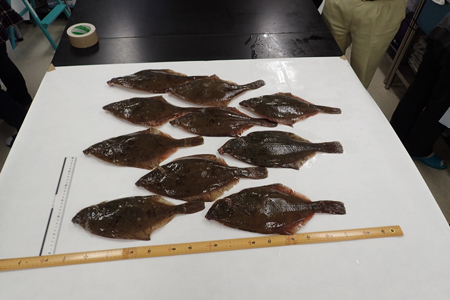“The results published regularly by Japanese authorities are precise.”
“Fukushima: Japanese Government Guilty of Destroying Pacific Ocean” runs a headline from earlier this year on a website known for dubious news stories. Although wildly exaggerated by the article, some concerns linger among environmentalists, scientists, and others about how much damage marine ecosystems suffered from Japan’s 2011 Fukushima nuclear disaster and whether Japanese data on the effects are trustworthy. The International Atomic Energy Agency (IAEA) has decided that they are.
“After 3 years of interlaboratory comparisons and proficiency tests, we’re able to make the conclusion very confidently that the results published regularly by Japanese authorities are precise,” IAEA Environment Laboratories director David Osborn said at a 28 September press briefing in Tokyo about marine radioactivity measurements.
Radioactivity Levels Have Fallen

The study examined Japanese data from samples of seawater, marine sediment, and fish taken near the stricken Fukushima Daiichi nuclear power station, which underwent meltdowns following the magnitude 9 earthquake and tsunami of March 2011. Samples were taken at five locations during six missions carried out from 2014 to 2016. The testing revealed very low levels of radioactive contamination, Osborn said, including cesium-134 at 5 becquerels (Bq) per kilogram (kg) in fish samples from 2015 and 2016. That amount falls far below the Japanese food safety limit of 100 Bq/kg.
The findings accord with recent results from Japan’s Fisheries Agency. In 2011, its weekly inspections recorded nearly 700 samples of fishery products with a radioactive cesium concentration of over 100 Bq/kg compared to 1,079 samples with amounts under that limit. The tallies dropped over the next few years, and since April 2015, it has not recorded any samples over the limit. Meanwhile, Japan’s Nuclear Regulation Authority has been publishing results from its Sea Area Monitoring program, with seawater samples taken at 2, 2–20, 20–100, and more than 200 kilometers from the Daiichi site.
International Participation in Monitoring

The IAEA began working with Japanese labs in 2014 while acting in a support role to the Japanese government’s marine monitoring program. It collated data from seven labs in Japan, as well as one lab each in Ireland and New Zealand in addition to the IAEA Environment Laboratories in Monaco. Each facility tested the samples for cesium-134, cesium-137, strontium-90, tritium, plutonium-239, and plutonium-240. The final IAEA report details how the labs performed tests using liquid scintillation counting for tritium, gas flow proportional counting for strontium, alpha-ray spectrometry for plutonium, and gamma-ray spectrometry for cesium.
“Over 98% of the results were not statistically different from each other, which shows a high level of consistency among participating laboratories,” Osborn said. “This demonstrates a high level of accuracy and competence on the part of Japanese laboratories involved in the analysis of radionuclides in marine samples for the Sea Area Monitoring program.”
Questions and Concerns Remain
“I do welcome the IAEA conclusion, and I do trust the data of the government monitoring program,” said Jota Kanda, a professor at the Tokyo University of Marine Science and Technology. He questions, however, the way the monitoring program was implemented. Kanda coauthored a 2014 study of plutonium and radiocesium isotopes in the marine environment around the crippled power plant.
Kanda said a more comprehensive monitoring design, with more sampling stations and more frequent samplings, might have provided a fuller picture of the initial radioactivity dispersion and answered other questions that remain unresolved today. For instance, although the total released radioactivity has been well estimated, the variation of seawater radioactivity across the contaminated zone was not, according to Kanda.
“This [IAEA assessment] is going to lend confidence to Japanese government testing, but it’s not going to answer every question.”
Jay Cullen, a professor at the University of Victoria’s School of Earth and Ocean Sciences in British Columbia, Canada, said he regards a proposal to release partially purified water to the coastal ocean as a matter of concern. “I am not aware of official estimates of how much [strontium-90], for example, might be associated with this partially purified water currently being stored on site.” In any case, he said, the high degree of accordance among the interlaboratory measurements suggests Japan’s findings are suitable for monitoring the disaster’s ongoing environmental impact.
Azby Brown drew a line between safety concerns and other considerations. “I think this [IAEA assessment] is going to lend confidence to Japanese government testing, but it’s not going to answer every question,” said Brown, who is lead researcher with Safecast, a citizen radiation-monitoring program formed amid the dearth of data in the aftermath of Fukushima.
“Even if a person ate a kilogram of 100-becquerel fish every day for a year, these doses are fairly low compared to a lot of other things,” he noted. But for him, there’s also a different ethical question. “Why should we accept any cesium in our food at all?” he asked.
—Tim Hornyak (email: [email protected]; @robotopia), Science and Technology Journalist
Correction, 12 October 2017: An error regarding the academic title of one of this article’s sources has been corrected.
Citation:
Hornyak, T. (2017), IAEA affirms Japan’s Fukushima-related radioactivity monitoring, Eos, 98, https://doi.org/10.1029/2017EO084563. Published on 11 October 2017.
Text © 2017. The authors. CC BY-NC-ND 3.0
Except where otherwise noted, images are subject to copyright. Any reuse without express permission from the copyright owner is prohibited.

